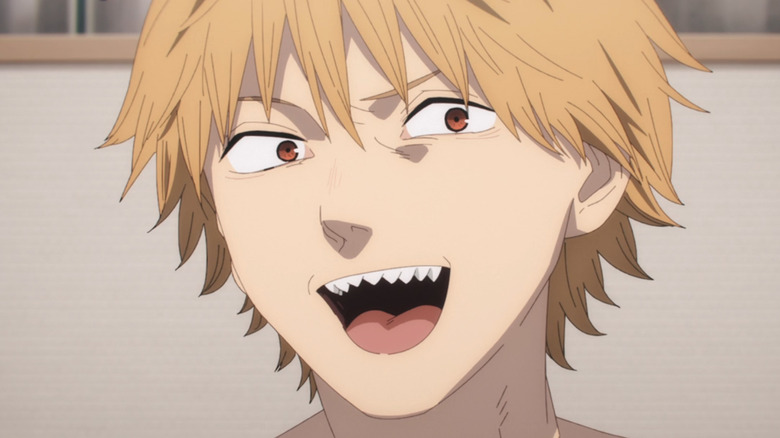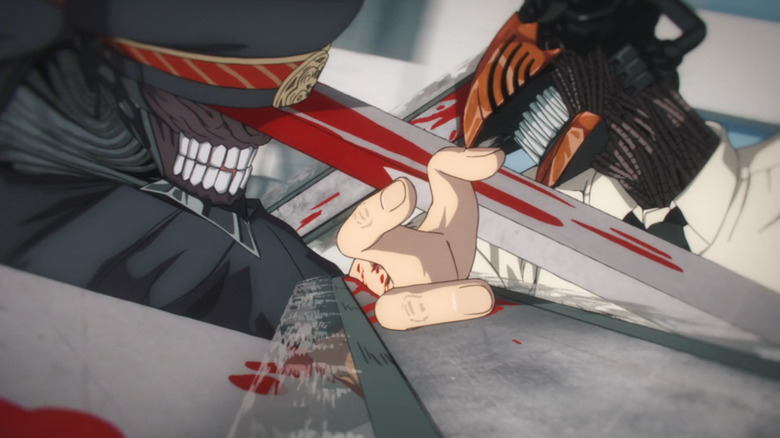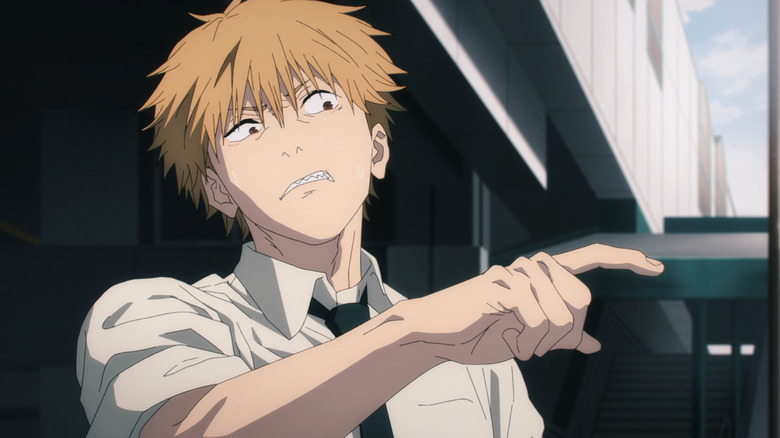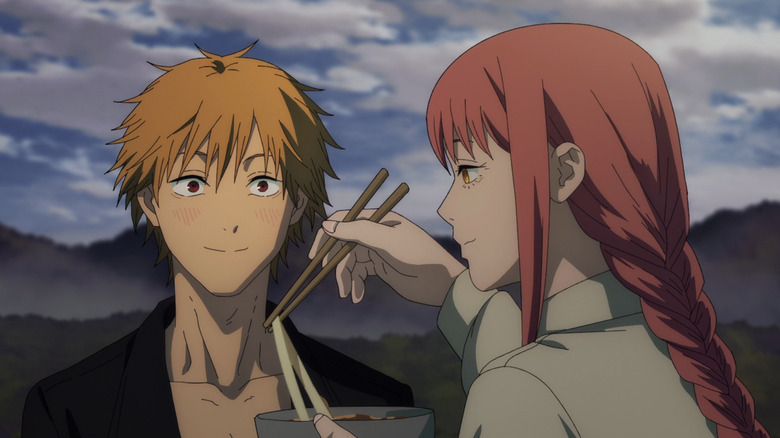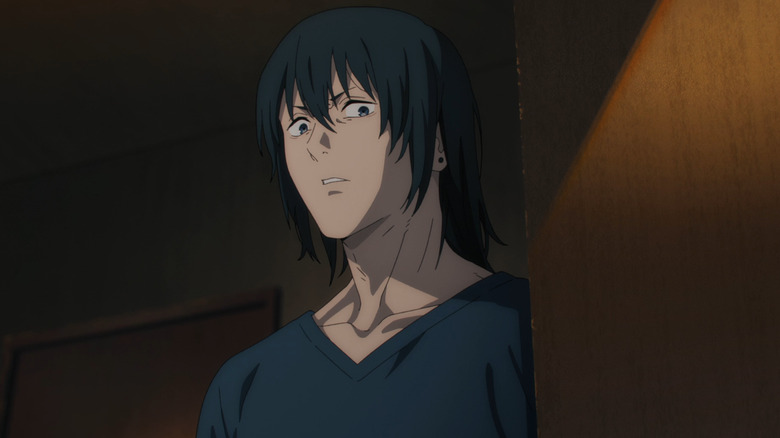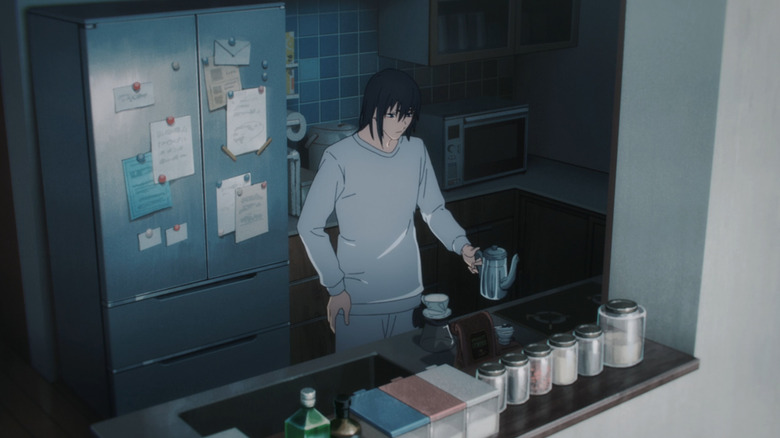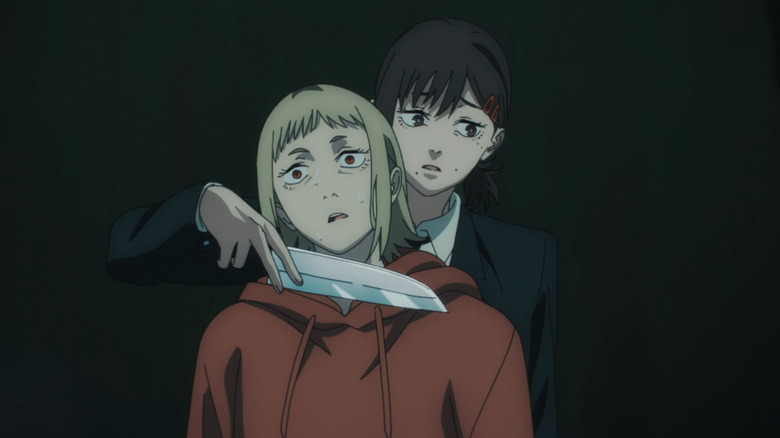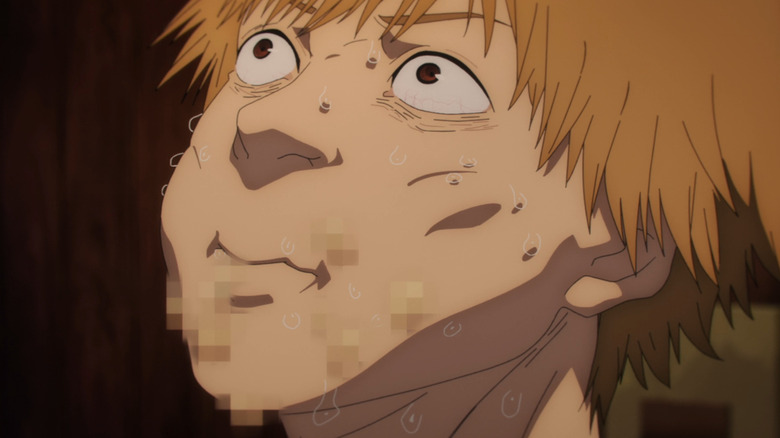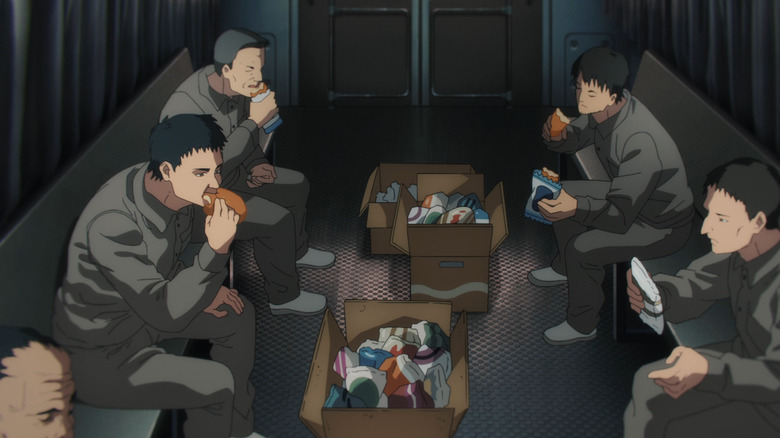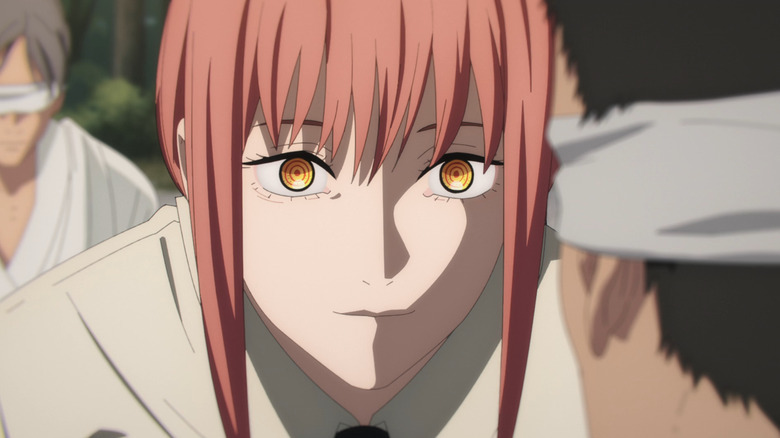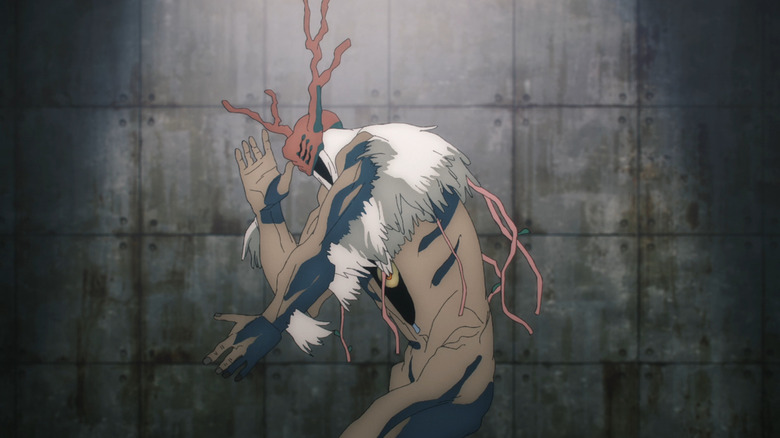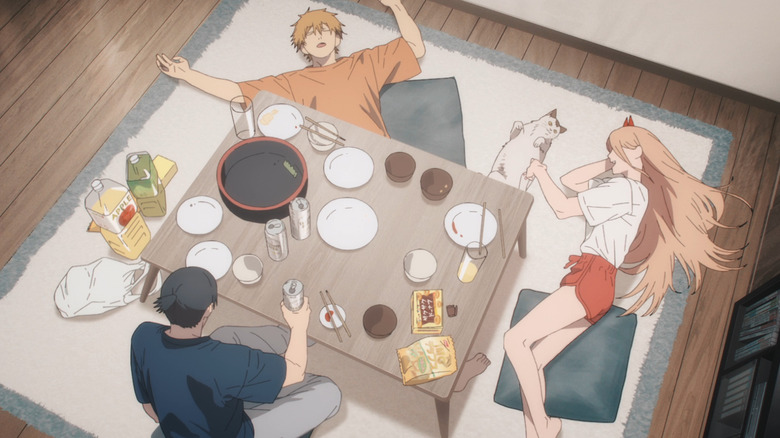The Biggest Differences Between The Chainsaw Man Anime And Manga
Are you watching "Chainsaw Man"? There's a good chance the answer is yes: Ever since it first hit the airwaves, the saga has earned legions of fans, easily landing it a spot among the best anime of 2022. And for good reason, too — this is one of the most entertaining anime series currently being made. "Chainsaw Man" tells the story of Denji, an orphan boy mired in poverty who wishes for a normal life. Things get complicated when he makes a contract with Pochita, the Chainsaw Devil. Granted the power to sprout razor-sharp chainsaws out of his flesh, Denji begins a new life that is anything but normal. As the newest Devil Hunter in Public Safety, he's expected to put his life on the line to protect citizens from murderous Devils, even if it means getting chopped up and brutally beaten on a daily basis.
With Season 1 of "Chainsaw Man" now completed, there's never been a better time to take a look at how the celebrated anime stacks up against the beloved manga. Compared to other anime adaptations like "Fullmetal Alchemist" or "The Promised Neverland," the "Chainsaw Man" anime has done a pretty good job of staying true to the original story. Still, there are a handful of notable differences between the two stories, which might make watching the anime worth it, even if you've already read through the manga. From added scenes to wild visuals, these are the biggest differences between the "Chainsaw Man" anime and manga.
The anime doesn't keep the manga's rough art style
To fans of the "Chainsaw Man" anime who haven't seen any panels from the manga, it may come as a surprise to learn that the anime's visuals are dramatically different from the source material. The anime is filled with vivid art that is typically either gorgeous or disturbing to look at, and occasionally both at the same time. The series' action-packed battle scenes are especially well done. A particularly great example is the epic final fight between Denji and Samurai Sword on a moving train in Episode 12. The two blade-wielders duke it out in a beautifully crafted and choreographed battle sequence, until Denji slices his foe in half and comes out victorious.
In contrast, the manga has a much rougher feel to its visuals. This is most apparent in the character drawings. Characters' faces are often depicted with exceptionally sketchy lines, even by manga standards. To some fans, certain panels might even appear incomplete. That being said, these visuals do not take away from the story as a whole. In fact, the sketchy aesthetic complements the quick pace, dry humor, and grotesque characters that make the series what it is.
The manga is more abrupt
The "Chainsaw Man" anime follows the manga's plot very closely. A few scenes might be added or omitted every now and then, but the overall story remains the same. And yet, for some reason, the manga feels as though it moves at a much quicker pace. How can this be? It probably has a lot to do with the art style, and the way in which the manga's chapters are divided.
As the manga's visuals are more sketchy than the anime's, readers may find themselves spending less time absorbing them. Instead, they're likely to focus on speeding through the series, to take in as much of the fast-paced story as possible. In contrast, anime viewers linger over the beautiful artwork to appreciate all the finer details that aren't present in the manga.
Then there's the pacing. A battle in the manga might be over before you know it in an explosion of roughly-sketched lines. Each chapter tends to go by in the blink of an eye, often ending with a sharp one-liner. But the anime isn't anywhere near as abrupt. It features smoother transitions between scenes, which keeps the flow of story consistent and the tempo of events far more regular.
An early manga scene didn't make the cut
In Episode 2, Denji and Makima stop for udon on the way to Tokyo. Still exhausted from fighting a swarm of zombies, Denji suddenly faints. He wakes up later to eat his soggy noodles. Believe it or not, this sequence actually omits an interesting scene from Chapter 2 of the manga.
As Denji and Makima order their udon in the manga, they're interrupted by a panicked father seeking help to save his daughter from a Devil. Makima orders Denji to kill the Devil while she eats, but the boy faces a moral dilemma when he finds the daughter happily playing with the Devil. The little girl even defends the Devil, claiming that it's actually saved her from her abusive father. Denji genuinely feels bad about having to kill a goodhearted Devil, and offers to run away with them so no one has to die.
The Devil then reveals its true intentions and attempts to kill Denji. With the help of his chainsaws, Denji is able to cut down the Devil and save the little girl. He then returns to Makima, falls over, and finally gets to eat his soggy noodles. Although it would've been cool to see that whole scene animated, it's not really a major piece of the plot. Still, anime fans will be surprised to learn what they've missed out on.
The anime reveals Aki's pet peeve
After joining Special Division 4, Denji moves in with his colleague, Aki Hayakawa, in Episode 2. As a kid who comes from poverty, Denji isn't used to living in a nice home and unintentionally disturbs the peace in the Hayakawa household. He makes a huge mess while eating jam and toast, soaks too long in the bathtub, and falls asleep on the toilet. This problematic behavior clearly bothers Aki, and the anime gives him one more thing to be upset about: Denji uses up all of the toilet paper and doesn't refill it with a new roll. For whatever reason, this small but relatable detail isn't in the manga.
In Episode 4, Power also moves in, and history repeats itself. This time, both Aki and Denji get mad when Power throws her food, refuses to bathe, and can't seem to flush the toilet. The anime once again throws in another small detail involving toilet paper. While Denji's problem was that he didn't refill the toilet paper roll, Power's problem is clogging the toilet with way too much toilet paper. Both situations are extremely frustrating for poor Aki, who just can't seem to catch a break. If it wasn't for his crush on Makima, he'd probably kick Denji and Power out instead of putting up with their antics every single day.
Aki gets extended screen time in Episode 4
Following the incident with the Bat Devil and Leech Devil, Aki and Denji have a conversation at the hospital about what really happened. Even though Power betrays Denji and attempts to kill him, he refuses to rat her out to Aki. In the manga, this scene ends with Aki deciding not to report Denji or Power, before cutting to the next scene, in which Power moves into the Hayakawa household.
In Episode 4, the anime actually extends Aki's screentime beyond the hospital scene. In that version, he proceeds to have a meeting with Makima to follow up on the incident. In his report, he defends both Denji and Power, hoping Makima can overlook the trouble they've caused since there were no fatalities. Makima agrees, but also implies that Aki has become softer since meeting Denji. Aki denies this assumption.
The episode then shifts to a calm sequence that gives us a glimpse of how Aki gets ready in the morning. It shows him doing everyday things like brushing his teeth, preparing coffee, reading the newspaper, and cleaning up. His quiet morning is sadly interrupted when Power barges in with the news that she's moving in.
The manga chapters often end with humor
Despite how much blood and gore exists in "Chainsaw Man," it still makes plenty of room for comedy through the characters' absurd personalities and the silly things they say without thinking. The anime squeezes in this humor between the action and horror, but the manga pulls it off in a different and distinct way. Oftentimes, the end of a chapter will feature something serious or sincere ... immediately followed by humor in the very last panel.
At the end of Chapter 2, for example, Denji asks Makima what kind of guy she likes. She gives him a sweet smile and says, "Someone like this boy named Denji." But instead of leaning into the romance, Denji gets a deadpan look on his face and responds, "Wait, that's me ... "
The end of the very next chapter shows Aki getting deep and serious about how he owes Makima his life. This gets Denji thinking about his fateful first encounter with Makima, in which she hugged him. He randomly blurts out, "I want to hug her again." Aki totally loses his cool and shouts, "Say what?!"
Later, in Chapter 35, Aki has a very emotional battle against Sawatari and the Ghost Devil. The timid Kobeni appears out of nowhere and helps Aki capture Sawatari. When asked why she hasn't quit working for Public Safety despite the risks, Kobeni wraps up the chapter with, "Because we get our bonuses soon ... "
The anime censors an unforgettable moment
One of Denji's first big missions with Public Safety is to exterminate a dangerous Devil inside a hotel. As a way to motivate the team, Himeno offers to kiss whoever kills the Devil first. Denji perks up when he hears this, takes matters into his own hands, and eventually defeats the Eternity Devil.
The team goes out for drinks some time later, and Denji is quick to remind Himeno about the kiss. After failing to outdrink Makima, Himeno kisses Denji in an incredibly drunken state and does the unthinkable: She throws up right in his mouth. To make things even worse, the poor boy swallows it and feels absolutely traumatized. This horrifying moment then triggers an ironic flashback, in which Denji and Pochita laugh at a group of rats for eating a pile of barf. While the barf is fully shown in the manga, the anime chooses to censor it, to protect anyone with a weak stomach.
The anime adds a little more context
With the quick-paced nature of the manga, it often feels as though there's not enough time for smaller details that set up what happens next. The anime, in contrast, tends to go back and fill in some of those storytelling gaps.
In Episode 9, Makima has Kurose and Tendo assist her in eliminating the gunmen trying to capture Denji back in Tokyo. To do this, she tells them to send 30 convicts to a shrine, where she'll take care of business with her secret powers. While the manga jumps right into her killing the gunmen and convicts simultaneously, the anime spends more time foreshadowing that slaughter by showing the convicts eating their last meals on the ride there. This gives viewers a huge clue as to what's about to unfold with Makima at the top of that shrine.
As the next mission begins in Episode 11, another short scene is added. The corresponding manga chapters focus on Aki's battle against Sawatari and the introduction of many new characters, like the Angel Devil and the Shark Fiend. While all of this is happening, it's unclear where Denji and Power are until they're suddenly shown in an elevator a few chapters later. Kobeni also makes a surprise return at the end of Chapter 35 to help Aki. To establish their whereabouts earlier on, the anime includes a scene where Denji, Power, Kobeni, and Aki all enter the building together and decide to split up.
Makima comes off different in the anime
Right from the get-go, Makima is a mysterious character who flip-flops between being friendly and being ruthless. She's the one who gives Denji a job, a home, and a purpose, but she also treats him like a dog and has threatened to kill him if he doesn't comply. She appears to do what's in the best interest of Public Safety, but by the end of Season 1, it's still hard to say whether or not she should be trusted.
That being said, the anime isn't as subtle as the manga when it comes to portraying her a certain way. In Episode 9, she reveals her ability to kill virtually anyone she knows the name of at the cost of another person's life. With this power, she sacrifices 30 convicts to kill her gun-wielding enemies. While this might be necessary for her to stop them from capturing Denji, the anime shows her with a creepy smile on her face as she slaughters all these people. The ominous sounds, screams, and pools of blood that pepper this sequence also aren't helping her case. The manga, on the other hand, keeps her expression and demeanor slightly more neutral and a lot less murderous. Regardless, there's no telling what Makima's true intentions are, or how many secrets she's hiding from everyone else.
The anime gives the Future Devil a more memorable introduction
Many of the Devils in "Chainsaw Man" are bloodthirsty and problematic characters who need to be dealt with by Public Safety to minimize damage and casualties. However, there are also cooperative Devils, like Pochita and the Fox Devil, who are willing to lend their powers to the Devil Hunters they form contracts with. After Aki loses the Fox Devil's trust, he needs to form a new contract with a different Devil. That's when Kurose and Tendo decide to set him up with the Future Devil in Episode 11.
Out of all the Devils in the series so far, the Future Devil might be the silliest and most enthusiastic. When he meets Aki, he swiftly reveals his peppy voice and dances while chanting his catchphrase, "The future rules!" He encourages Aki to join in on the fun and has a brief moment of sadness and anger when his offer is ignored. Then he starts wiggling his body around like a child while Aki has his future read. He even earns a spot in the Season 1 opening, which sees him dance his heart out. Unfortunately, the Future Devil's silly behavior doesn't shine through as much in the manga, since we can't hear his voice or see his dance moves in action. Moreover, now that he lives in Aki's right eye, we might not get to see much more of him.
The end of Episode 12 is a lot more peaceful
In the Season 1 finale, Aki wraps up his fight against Sawatari and the Ghost Devil while Denji successfully defeats Samurai Sword. With Samurai Sword all tied up, Denji and Aki have fun kicking him around as a way to avenge their fallen comrade, Himeno. At the same time, Makima sets the stage for the next season by revealing that they can now track down the Gun Devil.
Afterwards, the anime adds a wholesome clip of Aki, Denji, and Power spending the day together as the credits roll. The three play at the park, do some grocery shopping, and end the night with a nice family-style dinner at home. This leads to a quiet moment in which Aki can finally relax, accept Himeno's death, and smoke the special cigarette that reminds him of her. Considering how the story has gone so far, it's safe to assume that these anime-exclusive scenes serve as the calm before the storm. It's only a matter of time before their lives are interrupted once again by a new set of Devils and villains.
